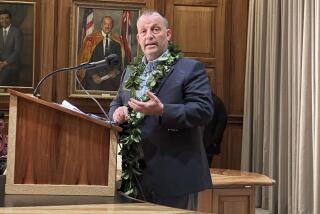Native Hawaiians Mark Bitter Centennial With New Nationalism
- Share via
HONOLULU — Flags of Hawaii and America waved at Iolani Palace that lucent August afternoon in 1898 as Sanford B. Dole crowned years of scheming by his fellow revolutionaries.
Five years before, they had overthrown Queen Lili’uokalani and established an American-dominated provisional government, with Dole as president. Their one policy: persuade the United States to annex the islands so their sugar plantations would prosper.
Aiding this persuasion was manifest destiny, the notion that U.S. expansion from Atlantic to Pacific and even beyond was divinely ordained.
And so, on Aug. 12, 1898, as the Royal Hawaiian Band played the “Hawai’i Pono’i” national anthem, the United States received a Pacific jewel from the pineapple baron.
“The spectacle was one of a lifetime,” reported The Pacific Commercial Advertiser, a pro-annexation daily. But few of the 40,000 Hawaiians witnessed it, the newspaper said.
Most, including Queen Lili’uokalani, shuttered themselves in their homes, protesting what they considered an illegal transaction.
“When the news of annexation came it was bitterer than death to me,” her niece, Princess Ka’iulani, told the San Francisco Chronicle at the time. “It was bad enough to lose the throne, but infinitely worse to have the flag go down. . . .”
A century later, bitterness remains in many of the state’s 208,000 people of Hawaiian descent, about 20% of the population. Although Hawaiians have two state agencies specifically addressing their needs, many feel ignored in their homeland.
“Even today, as we look at the plight of the Hawaiians, sometimes some people refer to that date when that change came about,” said Sen. Daniel Akaka (D-Hawaii). “The Hawaiians started to decline; the ills that Hawaiians suffer today can date to that time.”
For many Hawaiians, the annexation centennial is a time to look inward and discover what they were and what they want to be.
A resurgent nationalism has spread among the kanaka maoli, or indigenous people. Today’s Hawaiians are renewing study of their endangered native language, discussing restoration of the monarchy, and seeking federal recognition of some form of Hawaiian self-rule. There’s even talk of independence.
Hawaiians want control of 1.4 million acres of crown lands ceded to the federal and state governments during annexation and statehood. That’s one-third of the state, including part of Honolulu International Airport and Pearl Harbor.
*
On Wednesday, about 5,000 Hawaiians marked the centennial with the sounds of conch shells, whistles and cheers as the state flag was raised over Iolani Palace. Then the Royal Hawaiian Band struck up “Hawai’i Pono’i.”
“It’s a crossroads in our history,” said state Rep. Quentin Kawananakoa, descendant of Prince David Kawananakoa. “How are we going to address those concerns that have been overlooked, perhaps for 100 years?”
Through their native tongue, increasingly. Nearly extinct after the American-dominated provisional government banned it from classrooms in 1896, the Hawaiian language lives on.
A 1978 amendment to the state Constitution made Hawaiian the second official language, and schools throughout the islands teach it. Taxpayers spend $1.1 million a year on public schools’ immersion programs, and private immersion preschools are full.
“The language permeates the life and culture, connects you to past and future,” said William “Pila” Wilson, co-director of the graduate Hawaiian program at the University of Hawaii at Hilo.
“It creates a connection with people throughout time.”
One of the people most revered by Hawaiians is Queen Lili’uokalani, the island’s eighth and last monarch. She was overthrown in 1893 by Dole’s cabal because she did not share its goal of annexation.
At a recent conference on the future of Hawaii, which became a state in 1959, advocates proposed restoring a monarchy. They believe that it would help jump-start tourism, the state’s leading industry, which has been lagging lately.
The king or queen would have real power to help Hawaiians by being a board member of the state Office of Hawaiian Affairs and the Department of Hawaiian Home Lands, which manages a federal homestead program. The monarch also would have ceremonial duties, including representing Hawaiians at the U.N.
“The wonderful and unique qualities of Hawaiian culture could, at last, emerge on a world stage,” said C. Richard Fassler, a non-Hawaiian who put forth the idea.
While some Hawaiians envision a monarchy integrated into a state government, others want to secede. Some call for a return to the islands’ pre-Western civilization and traditions. Still others simply seek federal recognition as a people with distinct aboriginal and political rights.
“There are many little groups and each one seems to have gone regional,” said Bill Souza, coordinator of a federally funded Hawaiian center at Leeward Community College on Oahu. “There’s no real consensus of moving forward.”
One group, Ha Hawaii, plans a mid-1999 sovereignty convention, but other groups will boycott because they were not involved in the planning.
*
Unifying the self-determination movement could become essential. Hawaiians could lose their race-based government benefits as a result of a 1995 U.S. Supreme Court ruling that urged closer scrutiny of such programs. To keep those benefits, at least one scholar argues, Hawaiians must establish a sovereign relationship with Washington, much like American Indians have.
For now, Hawaiians are unified only in recalling the August day 100 years ago, when their nation was given away.
“Those who were present covered their eyes as their beloved flag was lowered,” wrote Bernice Piilani Irwin, a friend of Queen Lili’uokalani, “while tears streamed down their cheeks.”
AP writers Ben DiPietro, Bruce Dunford and Ron Staton contributed to this report.
More to Read
Sign up for Essential California
The most important California stories and recommendations in your inbox every morning.
You may occasionally receive promotional content from the Los Angeles Times.










